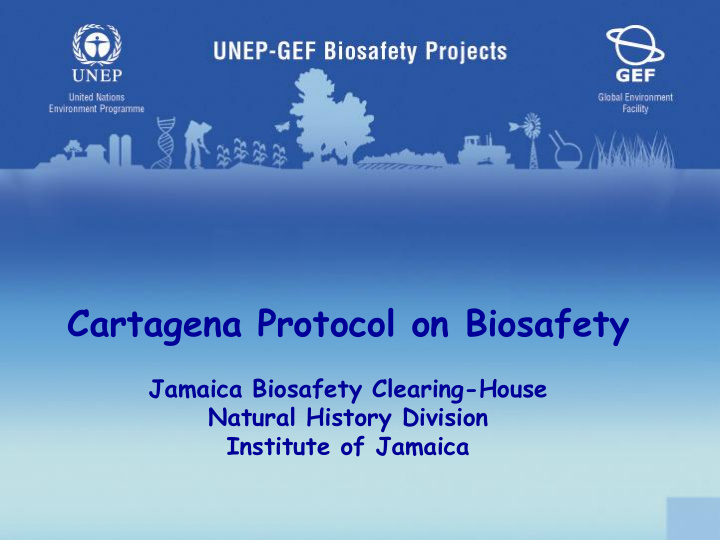



Cartagena Protocol on Biosafety Jamaica Biosafety Clearing-House Natural History Division Institute of Jamaica
What is the Cartagena Protocol on Biosafety? • A “ Protocol ” is an agreement adopted within the framework of another international agreement. • The Cartagena Protocol on Biosafety is an international agreement (treaty), concluded and adopted in the framework of the Convention on Biological Diversity (CBD). – The CBD has much broader aims regarding the conservation and sustainable use of biological diversity and the sharing of benefits arising from the use of genetic resources .
Convention on Biological Diversity (CBD): 1992 First global treaty to provide a comprehensive framework on all aspects of biodiversity 3 goals: - conserve biodiversity - sustainable use - ABS Benefits Sharing 188 Parties
CBD Goals and Biotech. Governments recognized that modern biotechnology has the potential to contribute to achieving these 3 goals…as long as it is developed and used with adequate safety measures for the environment and human health.
Cartagena Protocol on Biosafety (CPB) Agenda 21/CBD (Rio 1992) COP 2 (Jakarta 1995) CPB (Montreal 2000) CPB in force (2003) 147 Parties as of 14 June 2008
What does the Biosafety Protocol do? The objective of the Protocol is to contribute to ensuring an adequate level of protection in the field of the safe transfer, handling and use of LMOs resulting from modern biotechnology that may have adverse effects on the conservation and sustainable use of biological diversity, taking also into account the risks to human health, and specifically on transboundary movement.
What is the Cartagena Protocol on Biosafety? • The Cartagena Protocol on Biosafety to the Convention on Biological Diversity, was adopted on January 29, 2000 and entered into force September 11, 2003. • Jamaica signed the Protocol in June 2001 indicating general support for the principles of the Protocol as well as the intention to become legally bound by it.
CPB Architecture Objec ectiv ive Precautio ionary ry Approac oach Procedu ocedures Handli ling Risk k Transp sport Info fo Assessment • AIA Packagin ing Sharin ring Identif ific icatio ion Risk k • LMOs-FFP FFP (BCH) H) Mana nagement nt • Documentatio ion fo for shipment SUPPOR ORTIN ING G MECHANISMS ANISMS BCH, H, Capacity ty Buildi ding, Compl pliance, Liabi bility ty
CPB & Precaution (Principle 15, Rio Declaration) Governments may decide on basis of precaution not to permit a particular GMO to be imported across its borders….even if there is insufficient scientific evidence about the GMO’s potential adverse effects. (Arts.10.6 & 11.8)
Objective of CPB (Art. 1) Protection of biodiversity, the environment and human health, special focus on transboundary movement of LMOs
Scope of CPB (Art. 4) Applies to LMOs : transboundary movement transit handling use Exception: Pharmaceuticals for humans (other international agreements / organisations)
Categories of LMOs (Art. 7 & 11) & Focus Intentional introduction into environment (e.g. seed for planting) Direct use as food, feed or for processing (LMOs-FFP) (e.g. GM- corn for human consumption) Contained use (e.g. GMOs for laboratory use, R&D)
Key Elements for Operation of CPB Advance Informed Agreement (AIA) procedure (Art.7) Special procedure for agricultural commodities (Art.11) Documentation for HTPI (Art.18) RA, RM & ERP (Arts. 15 & 16, Annex III) BCH (Art.20)
Advance Informed Agreement (Art.7) Applies to first intentional transboundary movement of LMO for intentional introduction into the environment of the Party of import Not for LMOs-FFP (Art.7.2)
Advance Informed Agreement (Art.7) Exception: Not applicable to TB movement of: pharmaceuticals (Art.5) transit & contained use (Art.6) LMOs decided by COP/MOP, unlikely to have adverse effects (Art.7.4)
AIA procedure: Steps Acknowledgement Notification (Art.8) (Art.9) (Exporters) ( Importing Party Within 90 days) Review of decision Decision-making(Art.10) (Art.12) (maximum 270 days)
AIA procedure: Discretions Opt out of AIA by Applying: Domestic framework - Art.9.2 (c) Simplified Procedure: Inform the BCH imports of LMOs to be exempted from AIA (Art.13) Conditions: Domestic regulatory framework or adequate safety measures in place
Procedure for LMOs-FFP (Art. 11) Sharing information: - Inform BCH of final decisions on domestic use of LMOs within 15 days - Provide information specified in Annex II - Ensure accuracy of information Decision making on import ( Art. 11.4): Subject to domestic regulatory framework Precaution (Art.11.8)
LMOs for FFP (Art. 11.6) In the absence of domestic regulatory framework: (Developing and EIT Parties) Risk assessment based on CPB Decision making within 270 days Silence not to imply consent or refusal
BCH and Simplified Procedure (Art.13) A party of import …specify in advance to the BCH: Cases when TB movement occurs at same time as importing Party is notified LMO imports exempted from AIA
Decision making and Timeframes Party of import shall acknowledge receipt of notification… within 90 days (Arts.9.1) Party of import shall communicate decision to the BCH and the notifier within 270 days of notification (Art. 10.3)
Risk Assessment (Art. 15) Scientifically sound manner (Annex III) Utilizes recognized RA techniques Assists in decision making (Art. 10) May require exporter to carry out RA Cost borne by notifier
Risk Management (Art. 16) Measures to regulate, manage & control risks Risk management depends on RA result Prevents unintentional TB movements Appropriate observation period LMOs with adverse effects identified & mitigation measures developed
Documentation Requirements (Art. 18) Identification in compliance with requirements of country of import: LMOs-FFP: “ May contain ” LMOs for introduction into the environment: Clear identification/Declaration of Conformity with the Protocol LMO for contained use: Clear identification/requirements for safe handling
Information Sharing & BCH (Art. 20) Obligatory Information to BCH: National Law and regulation Bilateral/Regional/Multilateral Agreements Summaries of Risk Assessment Decisions on imports and release of LMOs National reports Decisions under AIA and Article 11 Contact details (NCA, NFP and emergency)
Socio-economic considerations (Art. 26) In reaching decisions on import of LMOs : May take into account socio-economic considerations arising from the impact of LMOs on the conservation and sustainable use of biodiversity, especially with regard to the value of biodiversity to indigenous and local community Consistent with Parties’ international obligations
THANK YOU
Recommend
More recommend